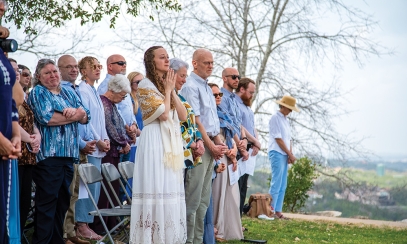
St. Sergius influenced Russian spirituality in the 1300s
Barfolomey (Bartholomew) Kirillovich was born on May 3, 1314, into a wealthy aristocratic Russian family. He was about 15 when the rulers of Moscow attacked their town of Rostov, and he was forced to flee with his family. They lost everything and were forced to work as peasant farmers at Radonezh.
Barfolomey (Bartholomew) Kirillovich was born on May 3, 1314, into a wealthy aristocratic Russian family. He was about 15 when the rulers of Moscow attacked their town of Rostov, and he was forced to flee with his family. They lost everything and were forced to work as peasant farmers at Radonezh.
Bartholomew was literate enough to study the Bible and developed a longing for the solitary life.
After his parents died, he and his brother Stephen became monks and lived as hermits. They chose a site for a hermitage in a wild forest location and built a wooden hut and a chapel there. Paul Burns wrote in Butler's Lives of the Saints that a priest from Kiev dedicated the settlement to the Holy Trinity — an unusual dedication in Russia at the time.
David Farmer writes in the Oxford Dictionary of Saints that the monastery re-established community life, which had ceased under the Tartars. After a few years, Stephen tired of the solitary life and left to join a community in Moscow. Bartholomew stayed on and received his tonsure from an abbot in the area, taking the name of Sergius. His reputation spread and disciples came to join him, each building a hut for himself. He agreed to be their abbot and was ordained a priest at Pereyaslav Zalesky.
Sergius’ insistence on the common life and prohibition of begging led to some discontent. Farmer writes that several monks wanted Stephen to be their abbot instead. So Sergius left to establish another monastery in the remote forest. He was later restored by the metropolitan Alexis.
Sergius lived a life of prayer and austerity, and his reputation for wisdom grew. He acted as mediator and peacemaker in political matters, and princes came to consult with him. One of these was the Great Prince Dmitry Donskoy of Moscow who was threatened by Tartar forces from the east. Burns writes that Prince Donskoy asked Sergius for advice and Sergius reminded him of his duty to protect his people and sent him away with two monks (former soldiers) to advise him.
Donskoy led Russian forces against the Tatars and Mongols and won the great victory of Kulikovo in 1380, which permanently removed the Tartar threat. A Britannica account reports that as a consequence of this victory, Sergius was hailed as the saint protector of Russia.
He became known for his ascetic life and his compassion for the needy. He taught the peasants better methods for cultivating the soil and traveled widely promoting peace.
Sergius became ill in 1392 and died on Sept. 25. He was buried in the principal church of the monastery of the Holy Trinity. This became a place of pilgrimage except during 1917-1945 when the Communist authorities closed the monastery and moved his relics to an “anti-religion museum.”
Canonized in 1448, Sergius is regarded as the founding father of Russian monasticism. He founded about 40 monasteries. Burns writes he is the prime example of “men of the wilderness” (pustiniky in Russian) who helped restore Russian society after the Tartar invasions in the 13th century.
Editor Bernard Bangley writes in “Butler’s Lives of the Saints” that Sergius is among the Russian Orthodox Church’s most popular saints and one of few who also appears on the Catholic calendar.
Mary Lou Gibson is a freelance writer who loves to explore the lives of saints. She is a member of St. Austin Parish in Austin.



